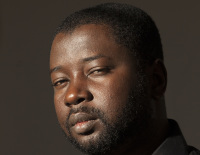CURRENT ARTISTS
The commitee of Malt AIR have selected artists based on a series of qualities as international experience from biennals, shows and galleries. The artists' contemplation in different matters of society, political aspects and use of material. The artists comes from all around the world, each bringing new knowledge and network to the Danish art scene.
Gabriela Sacchetto (Brazil)
Gabriela Sacchetto is a Brazilian visual artist based in São Paulo, holding a Master’s degree in Visual Poetics from the University of São Paulo (ECA-USP). Her work begins with attention as a creative practice, taking shape through observational drawing and painting on small fragments of discarded wood. These small-format pieces condense time and perception, presenting fragments of the urban landscape that gain density and silence.
She was nominated for the PIPA Prize in 2021 and has participated in several national and international exhibitions, including Afirmação – Exposition collective Brésil, l’affirmation d’une génération at La Fab, Galerie du Jour, Paris (2023); Do tamanho da respiração, a solo exhibition at Galeria ArteFasam (2022); Triangular – arte deste século at Casa Niemeyer (2019); and the 38th Ribeirão Preto Art Salon, where she received the Acquisition Award (2013).
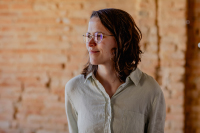

Alexandra Papademetriou (Greece/Sweden)
Alexandra Papademetriou (b. 1994) is an artist, researcher, and designer, currently based in Gothenburg, Sweden. She trained as a painter in her hometown of Athens, Greece (BFA in Fine Art and New Media, Middlesex University/AKTO College, 2015), before moving to Sweden in 2018 to further her studies (MFA in Fine Art, HDK-Valand, 2020). More recently, she completed the post-master course Of Public Interest at the Royal Institute of Art in Stockholm (2023).
Her work has been shown in exhibitions and conferences across Europe, and her writing has been published in journals, university publications, and exhibition catalogues.
Alexandra Papademetriou is an artistic researcher working through social engagement and text. Operating at the intersection of art and ecology, her work explores how artistic practices can provide the testing ground for environmental and social change, cultivating a sense of interdependency with the more-than-human. Using shared learning as method, she aims to facilitate interdisciplinary dialogues and collaborations.
Her current research focus is on the subject of degrowth, and specifically how degrowth thinking and strategies can be mobilised within artistic practices to create a more equitable and humane field. Through publications, exhibitions, and workshops, she aims to introduce more people into the degrowth discourse, while also creating spaces for other artists to come together and create strategies for social change.
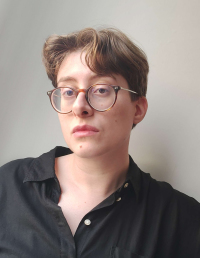
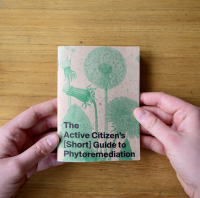
ARTISTS 2024-2025
Sidra Khawaja (Pakistan)
Sidra Khawaja is a Kashmiri interdisciplinary creative practitioner, educator, researcher, and a Fulbright scholar. Born in 1990 in Muzaffarabad–Kashmir (Pakistan), she completed her Bachelor in Visual Communication Design from National College of Arts Lahore (2015) and Master in Designed Objects from School of the Art Institute of Chicago, USA (2021). Her practice thrives at the intersection of design, craft, anthropology and cultural exploration. She weaves narratives bridging socio-political and cultural contexts through interactive public experiences using objects, installations, archives, and multimedia. Her work critically delves into material culture, sparking dialogue on decolonization, identity, representation, eco-feminism and climate change.
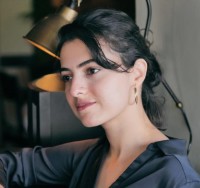
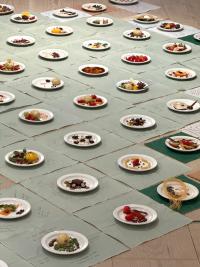
Paula Niño (Colombia/Germany)
Paula Niño (*1993) is an interdisciplinary artist from Bogotá, Colombia, where she received a BFA with honours in 2016, at the Pontifical Javeriana University. Later, in 2024, she completed her studies in Fine Arts, Painting and Graphics (Prof. Schirin Kretschmann) at the Academy of Fine Arts in Munich, Germany. Her artistic practice arises from a constant curiosity about life, the feeling of belonging somewhere, the invisible frame of every story, and all the ordinary things we have no explanation for. Themes such as migration, identity and memory emerge, which in turn are interwoven with the experience of writing and material processes. Her most recent works and research critically examine the migration policies of the countries she has lived in and expose them through hybrid and experimental installations where an intimate and personal voice reveals collective issues on a larger scale.

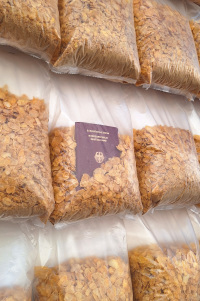
Fette Sans (France)
Fette Sans has a conceptual and interdisciplinary practice that includes the production of images, writing, performances, online gestures, film-making, discussions, and installations. In 2021, she wrote, directed, and performed in the 45-minute film AGIRLICA. It premiered in the BrotFabrik kino as part of her solo exhibition at Neun Kelche in Berlin. It won the prizes for best smartphone film at the 2022 Mykonos Film Festival and for best experimental film at ARFF Paris. In 2017, she staged a 5-month-long performance in a room of the Hotel Zoo Berlin where she lived, at no cost, during the entire time. This extensive project brought forth a series of videos, books and objects. Her ongoing performative work The bitter ends of (the technologies of tenderness) was performed at HAUS (Vienna), during Organ Vida (Zagreb), and at the festival Montag Modus (Alte Münze, Berlin). She has been giving lectures at the Volksbühne in Berlin, at the Bauhaus University, and during the Istanbul Biennial. She has been the recipient of grants from Stiftung Kunstfonds, Akademie der Künst, and Kunststiftung NRW.

Anna Jarosz (Poland)
Anna Jarosz (b. 1996) is a visual artist, filmmaker and producer. She graduated from the Film and Photography Department at FAMU in Prague, as well as HDK-Valand in Gothenburg. Her main mediums are traditional textile work (lacemaking, weaving and embroidery), painting, video and sculpture. She creates site-specific installations which transform spaces into abstract universes.
Jarosz’ work brings back to life forgotten stories of women and addresses themes related to intergenerational movement of trauma, emotional chaos and sexuality. In her latest projects, she draws from traditional Slavic folklore, mythology, and cosmology. She explores rituals passed down through generations by women in her family.
She is the initiator and curator of the GÁTT Nordic Arts Festival biennale. Together with Sanna Hirvonen she co-founded the artistic duo care and chaos whose activities focus on interspecies ecology, proposing forest as an utopian home and a space of interdependence. She has participated in the production of exhibitions and national pavilions at Venice Biennale of Art and Architecture (2022-2024).

Sofiia Holubeva (Ukraine)
Sofiia Holubeva (born 1997 in Odesa, Ukraine) is an interdisciplinary artist living in Berlin. In 2021, she completed her master's degree at the National Academy of Fine Arts (Monumental Arts), Kyiv | UA.
Holubeva creates site-specific art that combines different media such as paintings, graphics, performances, installations, objects, videos, and mosaics.
In her artistic practice, she focuses on exploring the themes of memory, the impact of war on human life and landscape, and how digitalization affects art. Sofiia is interested in the concepts of home and connection and often invites her family to participate in her projects. The artist explores the history of painting and the role this medium can play today.
Holubeva is an active participant in international exhibitions, residencies, art festivals, and projects in Ukraine and abroad. Sofiia has participated in exhibitions in Ukraine, Poland, Romania, Germany, Spain, France, Monaco, Denmark and other countries. Her works have been covered by such publications as Tagesspiegel, Frankfurter Allgemeine, Mitec, NWZ, Monopol, TAZ, and MorgenPost.


Elena Hoyos (Colombia)
Elena Hoyos (Bogotá D.C., 1999) is a designer and visual artist interested in large-scale and site-specific installations made with recovered materials. She graduated Magna Cum Laude in Design and Cum Laude in Art from the Universidad de los Andes (2023). She is interested in adding value to the waste materials that are produced, consumed and discarded daily, understanding and taking advantage of their properties to re-signify them and turn them into the raw material of each project. Interested in exploring places where objects and materials have been discarded for believing that they can no longer fulfill functions, seeking to reconsider the relationship of humans with the material world that surrounds them.
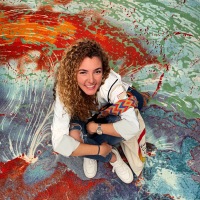
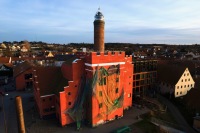
Hanna Råst (Finland)
Hanna Råst is a Helsinki based visual artist addressing themes of memory and trauma through sculpture, lens-based media, text, and installations. She often uses archival materials as her starting point to scrutinize how the past affects our present and future and what traces we leave behind.
During the residency at Malt AIR, Hanna Råst is addressing themes of empathy, care and softness in relation to her topics of memory and trauma. By focusing especially on performative and durational aspects of her artistic practice, and inviting the local art scene to a dialogue with her, she asks how we deal with memory and trauma in society and if the work of art can contain empathy when scrutinizing difficult topics.
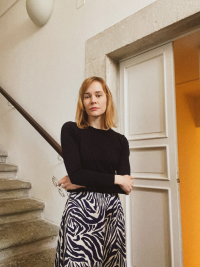
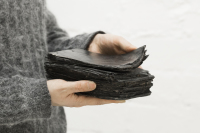
Lena Mai Merle (Germany/New Zealand)
Lena Mai Merle is an intermedial artist currently based in Wuppertal. In her practice, she deals with the depiction of inscription and different ways of seeing, reading, and interpreting it. This encompasses a crossroad of group relations, identity construction, autobiography, narrativization, othering, rhetorics and role structures. By weaving an entanglement of associations through image and text, her painted objects and figures not only exist as equals in this new dimension but can act beyond their ascriptions.
What language does an image need to catch that single, suspenseful second of a shift out of character, a Verrücktheit? During her residency, Lena will playfully research how to depict a falling out of character. Along with the concepts of performativity and what lurks behind a reflection, she opens a fissure into her rhizomical research and invites the outside, meaning you, in to probe and contemplate these questions together.
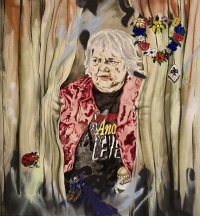

Sian Costello (Ireland)
Sian Costello uses performative self-portraiture, drawing, and the camera obscura, to reevaluate the hidden role of patience in the history of portraiture and figure painting. Her paintings reevaluate the largely uncredited role which the artist’s model has played in the history of art, the depiction of women in the western figurative tradition, and the wider ubiquity of the trivialisation of feminine-perceived labour.
Her current studio practice uses painting, performance and lens-based installation to interrogate the artist-model relationship. She is constantly searching for new forms of image making, digging through art history to revive extinct technologies and obsolete imageries. Within this process, she sees a huge potential for collaboration with other artists, particularly writers and performers, but also object-makers. She has ideas for installations based on gendered interpretations of furniture-making and garment-drafting, both of which seem especially pertinent within the context of MaltFabrikken and the rich history of Danish design. As a resident artist at Malt AIR, she hopes to diversify the ideas and processes behind her work.
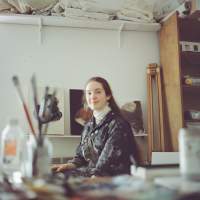
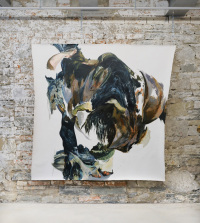
Laura Torres Bauzà (Spain)
Laura Torres Bauzà uses a multidisciplinary approach to explore the cognitive frameworks through which we, as a society, construct meaning and interpret reality. Her work focuses on how our symbolic and narrative legacies converge, seeking to analyze and present them in unconventional ways mixing a wide range of media (photography, video, installation, performance) with writing.
During her residency, she will immerse herself in the Ebeltoft archive, examining visual and textual documents. She aims to uncover the details and hidden narratives that shape the reality of Ebeltoft, with a particular focus on how the community presents and represents itself.
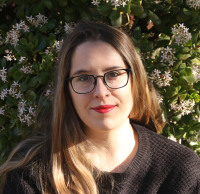
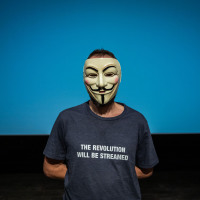
ARTISTS 2019-2023
María José Crespo (Mexico/Holland)
María José Crespo’s artistic research looks into how the porous space between territory, language, limits, and the body can be understood by amplifying gestures in different materialities. By questioning how she inhabits certain boundaries as a woman, she is interested in studying remains and traces that administrative powers leave behind in unclear territories.
During her residency at Malt AIR María José Crespo will continue to develop her new project “Aviso: female flickers over built environments”. She will enable an encounter between different female figures and their communication practices at the border between México and the United States. During the Mexican Revolution, Avisadores (signalers) were sending avisos with mirrors flickering a blinding flashlight notifying the whereabouts of the border patrol and other Mexican secrets. Few know about this communication method, but even less is known about women's activity. In this context, her research will explore the untold female perspective of the avisadores and how the avisos along with other informal gestures, allowed acts of autonomy in an environment of industrial and surveillance excess, reverberating this into a migratory current context.
María José Crespo will, during her residency, experiment with the form of speech and its multiple ways of understanding it nowadays through multimedia possibilities and settings to be performed or displayed. By using her voice to probe fiction, orality will be explored through enunciations in sound, making words stretch into sculpture, like malleable scripts looking for their materiality to take form on the different structures and spaces.


Elene Pichkhadze (Georgia)
Living through several immigration experiences, Elene's works are united with ideas of longing and belonging - a very vulnerable attachment to spaces and memories as autonomous, self-sufficient characters. Working in different mediums, like painting, sculpture, and video art, her pieces reflect a feeling of alienation shared between places, objects, and people. Elene's approach, influenced by both her design and art practices, often leads the artist to physically recreate and imitate places from her personal experiences and memories in new, detached environments.
'MOMA Surami' is a utopia-project, proposing the opening of a museum of modern art in the little Georgian village of Surami. It is discussing the role of art, museums, and institutions, objectified and placed in domestic and non-domestic spaces. Real photographic evidence of village life overlaps a completely fictive narration about the museum, creating one meta-event. Under these externally forced circumstances, the fragility of our boundaries and privacy becomes even more evident. With the project, the artist further explores the intrusive power of spaces, raising questions of territory, borders, and limitations.
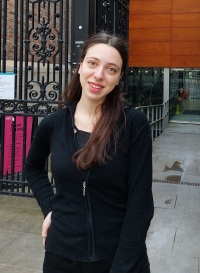
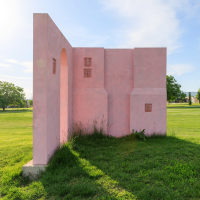
Anastasia Bogomolova (Russia)
Anastasia Bogomolova conducts research and takes an artistic approach to performative practices, and she documents her process through installations, photography, video, sound and text. In her projects, she studies facial expression as a theme, a methodology and a visual language and uses the imitation of everyday rituals as an artistic method. Her key themes are forgetfulness, the flexible nature of memory and the depiction of traces.
During her residency, she will further develop a project that in its original form thematised invasive species in nature, but which has taken on new layer of meaning for her in light of Russia’s invasion of Ukraine. As an artist in Russia, she daily asks ethical questions about her practice and her artistic language, and how, in her view, the invasion of the world of plants no longer appears to be solely an ecological phenomenon, but also symbolises the complete violation of boundaries.

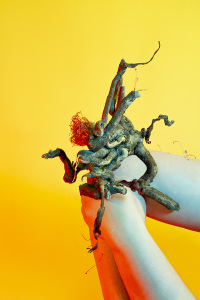
Renée Akitelek Mboya (Kenya)
Renée Akitelek Mboya is a writer, curator and filmmaker who mostly works on biographical and historical narratives. She is interested in images, and the ways in which they are produced has come to play a crucial role as an expression of white paranoia and aesthetic idioms about race and racial violence. She seeks to understand how images are used to reinforce the institutionalised narratives about the racialised body as a constant threat.
During her residency at Malt AIR, Renée will be involved with the East Asia Company’s Thai and Ghanian collections at the Siamesisk Samling Museum. The purpose of her project is to confront the persevering and pervasive colonial violence against indigenous peoples around the world and to identify the racist assumptions that exist in post-colonial historical narratives.
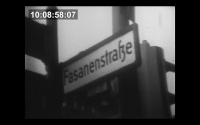
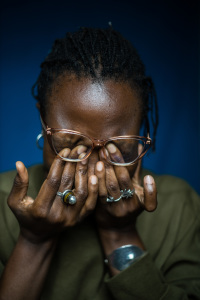
Fidel García(Cuba)
Fidel Garcia’s multidisciplinary artistic practice explores, challenges and deconstructs the technologies and knowledge systems that operate in power structures and supervisory bodies. In his works, he creates discourses which compel systems to undermine their own logic and technologies to attack themselves from within so power structures and supervisory systems are revealed and commented on via their own technologies.
During his residency, Fidel Garcia will work on the Despolitization project, a prototype for a social Utopia that seeks to demonstrate a new societal model to replace outdated systems that are no longer useful.

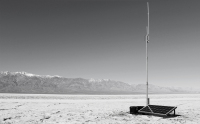
María Isabel Arango Velásquez (Colombia)
María Isabel Arango Velásquez uses a multidisciplinary approach to explore topics such as traumas, language and the formation of meaning. She questions communication systems, political discourse and the concept of history itself. Currently, she is focused on the necessity of relations and possible forms of communication between human beings and other species, and to achieve this goal, she is involved with the ritual as a form of expression.
During her residency, María Isabel Arango Velásquez will work on the project “Let the soil be as soft as your feathers”, a requiem for vanishing bird species and the ecological trauma that their impending disappearance will cause.
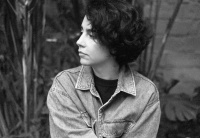
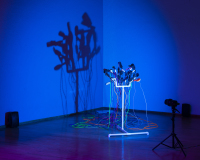
Anna Pasco Bolta (Spain/Germany)
Anna Pasco takes an interdisciplinary approach to art, technology and science, and her works often encourage her audience to interact. Her methodology unifies art theory, pop culture and science in a way that invites the recipient to question his/her role as an onlooker and the actions involved in observing a given work.
During her Malt AIR residency, Anna will further develop a launched project based on her interest in how information technology leaves behind traces that are closely associated with the earth, air and nature. Among other areas, the project is involved with fungal organisms, which have also been used in efforts to create biological computers based on the calculation and communication skills possessed by these monocellular organisms.
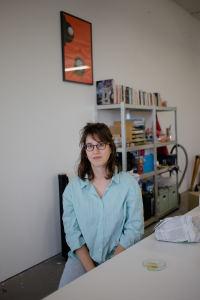

Chan Mi Heo (South Korea)
Using the traditional medium painting, South Korean artist Chan Mi Heo is trying to define what it means to paint and to define the norms associated to it. Instead of using brushes, Chan Mi uses blankets - often as a part of a performance, where she wraps herself in the blankets and at the same time uses them as a tool to paint. Using the landscape as the motive of these expressive paintings, Chan Mi also takes part of a long tradition of landscape painting, at the same time trying to liberate herself from this tradition.
During her residency in Ebeltoft Chan Mi wants to explore the landscape around the city and to discover how the foreign and unknown nature is gonna affect her artistic way of portraying it.
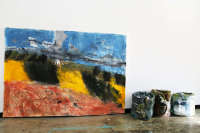
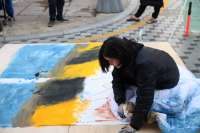
Stella Geppert (Germany)
Stella Geppert's works are born out of the analysis of movement in communicative and bodily states that are formed and shaped by social conventions. As a sculptor and performer, she defines the medium of drawing as a sculptural imprint of the essential movements of human interaction. Sculptural and performative work is therefore work on and with relationships, which is why she explores the question of the specific and transformational states of body and space, material and touch, contact and resonance.
During the residency Malt Air she will work on the aspect of empathy and nonverbal communication between humans and other species. The body’s sensual ability to "think itself into” space, body, material and substance is an important aspect of her work, in which she portrays the human body as extremely fragile and vulnerable.

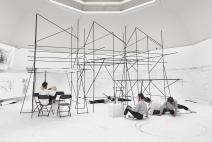
Ola Arent (Poland)
Ola Arent works in the field where art, social sustainability and environmental protection converge, and she is involved in projects such as guerrilla gardening, social urban gardens and interdisciplinary projects that bring focus to bear on topics such as social injustice, deforestation and the extermination of species.
During her residency, Ola Arent will explore the performative potential of veteranising trees, a practice that creates new insect habitats and, as a possible artistic conceptual technique, she wants to study how an industrial forest can be transformed into biodiverse art installations.
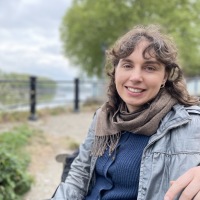
Asako Shiroki (Japan)
Asako Shiroki’s work revolves around various actions and processes that are derived from the natural materials out of which it is made. She dislocates mutual rules and suggests new relationships to happenings that occur simultaneously in this world, such as history and culture, customs, awareness of flora and fauna, and the phenomena between tangible and intangible things. She reverses and mix things, including concepts that ought to be on the reverse, reflects things in mirrors or peels away related meanings to let things themselves start a dialogue in different contexts. Working autonomously between a territory of self-defined-by-things and one of things-defined-by-self, she attempts to unfold and interpret several parallel worlds, oscillating between perpetually repeated cycles of recollection and oblivion.
During her residency at Malt AIR, she will investigate the views on nature among the people who live in this community.
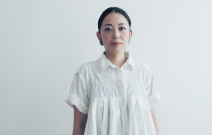

FRAUD (Canada/Spain)
During their stay they will work on their project EURO-VISION, an art-led enquiry by FRAUD into the extractive gaze of European institutions and policies, which focuses on the inscriptive operations of resource management.
Initiated in 2018 in collaboration with scholar and media practitioner Btihaj Ajana, the project seeks to make visible the many entangled modes of extraction that Europe enacts on third countries through the lens of its Critical Raw Materials Initiative. The initiative defines strategies for accessing resources viewed as imperative to the EU’s subsistence, and as such, brings into focus the covalence among international relations, trade, economic policy and border security.
More info here: https://euro-vision.net/
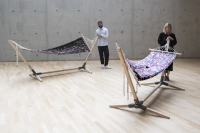
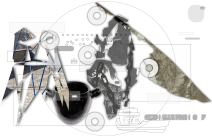
Song Min Jung (South Korea)
Song Min Jung observes the surface of culture that remains in the present - the temporal concept of time - and creates a fictional story using the contradictions that arise in between. She borrows several storytelling techniques such as advertisement, drama, v-logs and games to weave a new world and participate in contemporary discussion. Therefore, the world she summons much resembles the present.
During her stay at Malt AIR, Song Min Jung plans to search for a Danish novel written in the 20th century and translate it with Google Translate in order to either adapt or extract a new story by filling in the gaps created by the translators errors and lack of vocabulary. Her goal is to gather voices derived from different realities, such as historical background, cultural topography, physical body and language, and bring them into the present through her work. The world she creates here will infiltrate the gap between an unfamiliar body from Seoul and a remote city in Denmark to become a medium of connection.
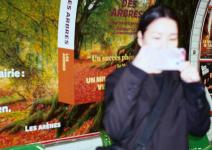
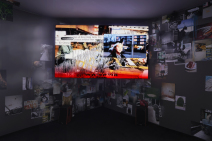
Negin Mahzoun (Iran/USA)
Negin Mahzoun was born in Tehran, Iran, and lives and works in Manhattan, NY. Her artistic practice focuses on observation, memory and gender in the context of her personal experiences, cultural identity through the women's body as an object and subject with the perspective of self-portraiture, and layers of history and literature. She expresses her work through various media and materials such as sculpture, installation, painting, printmaking and photography. She works primarily with canvas, treads, paper and water-based pigments to create a specific space for sharing existing life experience for the women apart from assumptions and oppressive laws governed by society.
During her stay, Negin Mahzoun is planning to work on a project in which she creates sculptures based on miniature painting, inspired by literature such as Haft Paykar/Seven Portraits by the Persian poet Nizami Ganjavi. She has already done the primary research for this and intends to experiment and make mockups with various materials during her residency, in order to find the best material for the project. The main goal is to make large-scale sculptures for public or private spaces, and finding the right material is an important part of the process.
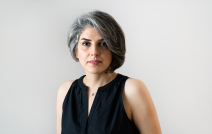
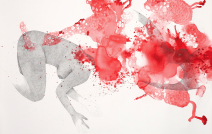
Chih-Chung Chang (Taiwan)
Working from his hometown, the post-industrial harbor city Kaohsiung, the artistic practise of Taiwanese artist Chih-Chung Chang is sited within the tension between human, civilization and nature. Meanwhile the starting point for his recent work is the industrial ports and the maritime culture.
During his residency at Malt AIR, Chang wants to explore the ports of both Ebeltoft and Aarhus. He wants to continue his research and art project on anti-fouling paint issues, focusing on the abuse of toxic ingredients and marine pollution. Sited in Denmark Chang is interested in exploring the Danish consciousness and responsibility concerning marine environment and pollution, and to interpret emotional bonds and stories about how oceans and ships connect people, from an East Asian perspective.
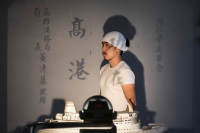

Ludovic Beillard (France)
French artist Ludovic Beillard is working across a wide spectrum of both sculpture, painting and installation. He is currently interested in a certain idea of utopia, which he sees, first of all, in the anecdotes, stories and popular myths of the working class. With references to Gothic sculpture, the medieval period and the comedia del arte (an early form of professional theatre) Ludovich composes his exhibitions in a theatrical way by incorporating grotesque aesthetics and exaggerating perspectives. During his residency at Malt AIR, Ludovich would like to continue to bring together model making, applied arts and religious sculpture to stage these anecdotes to bring them closer to a mystical essence.

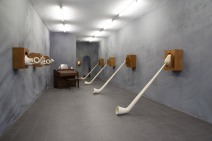
MAHBUB JOKHIO (PAKISTAN)
Mahbub Jokhio is from Sindh, Pakistan. Besides working on his own artistic practises, he teaches at Beaconhouse National University Lahore. Jokhio’s visual investigations often incorporate irony, a dark sense of humor and self-referential critiques that locate and decode the image’s capacity to mediate reality. Jokhio often makes slight alterations and manipulations in usual conventions to alter our view and perception towards the world. In general the artistic practise of Jokhio ranges widely in both content and stylistically.
The effect of climate change on the sea is a theme that has his special interest - from life in the sea to the rise of the sea.
With the workning title “Noah’s Dream” he will investigate how we in Denmark in general, and in Ebeltoft in particular, relate to the sea and the climate, with a view to finding new strategies on how to deal with the natural changes.
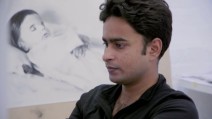
Paola Monzillo (Uruguay)
Working with mediums such as collage, drawing and installation, Monzillo is interested in challenging the supposed neutrality of historical data and geographical representation. She questions why these complex narrative fabrics and systems of representations look the way they do and points out how their configurations are connected to mechanisms for the political imposition of power.
Drawing on experiences both as an artist and architect, Monzillo has studied the contrast between cartographies of Native American sites and those produced by Spanish colonizers.
Lately she has been particularly interested in the myths told about the Danish vikings in regards to the discovery of America which will also be subject to her work during her stay at Malt AIR.
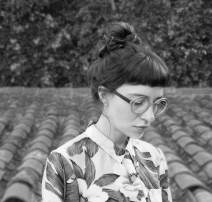
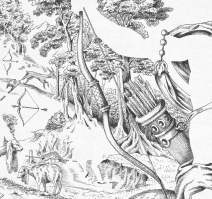
Nicholas Grafia (Germany)
Nicholas grew up in a city in Germany, where being in the minority as a person of color, he learned to find artistic inspiration in the feeling of being looked upon as different. His creative work unfolds through painting as well as performance art and video installations. During his stay at the Malt Factory, he hopes to get in touch with the local people and find inspiration for an art project which explores Ebeltoft's queer environment and invites to interpret on the concepts of identity and fragility when these meet in the intersection between life in a quiet small town and the city life.
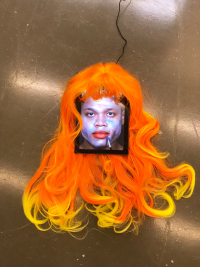
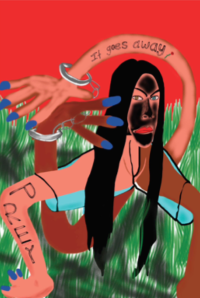
Chico Togni & Kadija de Paula (Brazil and Canada)
KADIJA DE PAULA & CHICO TOGNI are a duo of Brazilian/Canadian artists who create situations and happenings that question the value of resources and social practices.
They combine food, text, sculpture and performance to create "events" and social experiences that take place in structures and functional objects they build with found resources and materials, avoiding the use of things that should not have been created or that will soon be depleted.
Interested in degrowth as a political and economic movement that can keep us going on as a society, Kadija and Chico research habits and processes of consumption, disposal, recycle, and social assistance to make self-organizing and alternative economical experiments that challenge how we consume, accumulate, exchange, share, and waste an abundant surplus of resources.
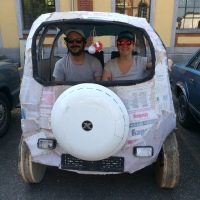
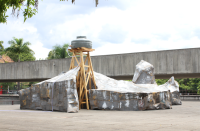
Karolin Schwab (Germany)
Through her art Karolin Schwab seeks to unfold the emotions and questions that arise in the encounter between the inner and outer landscapes; between human and nature. By creating art installations in natural landscapes and vice versa by bringing the landscape into the exhibition space in form of sculptures and pictures.
The location of Maltfabrikken in the National park of Mols Bjerge creates a good match with Karolin's work. Especially the geographical location by the ocean front and the coast on the opposite side of the cove, inspires future works that will explore the distance and the water connecting the stretch.
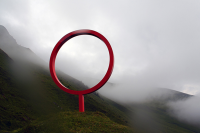
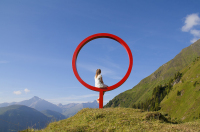
Kelani Abass (Nigeria)
Kelani Abass from Nigeria grew up in a family working with the traditional handcraft of letterpress. Within this family business, Kelani has found his source of inspiration, as his art today deals with the craftsmanship and the technologies that the printing industry has used through time.His art unites personal stories with historical events, thus creating new narratives that comment on collective memory, time and technology. Kelani hopes to be able to benefit from the Maltfabrikken’s museum, library and archive for immersed research work.

